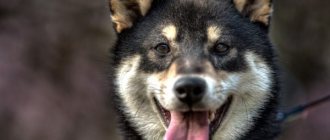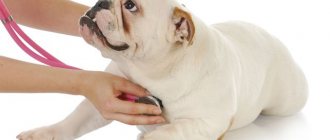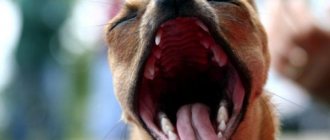Owners sometimes notice rapid breathing in their dogs. And there can be many reasons for this: from a normal physiological phenomenon to the manifestation of a disease or, even worse, the occurrence of a condition that threatens the pet’s life. Therefore, you should be aware of this pathology so as not to make mistakes and take timely measures.
Possible causes of rapid breathing in dogs
When inhaling, animals use their nose, but during intense jogging or hot weather they replenish their oxygen reserves using their mouth. If a dog breathes heavily and frequently while at rest, there is a high probability of pathology. Possible reasons include:
- Heatstroke
. Overheating can occur not only outdoors, but also in a stuffy room.
- Allergies
. The main symptom is supplemented by discharge from the eyes and nose, cough and itching. With an acute lack of oxygen due to swelling of the larynx, suffocation may occur.
- Diseases of the gastrointestinal tract and endocrine system (hypothyroidism, diabetes mellitus)
. Any disturbances from the gastrointestinal tract are accompanied by vomiting, upset stool and loss of appetite. With ascites, the dog's temperature rises and his stomach swells, which interferes with his usual activities. Hypothyroidism is characterized by a strong decrease in temperature and rapid weight gain. The onset of diabetes mellitus can be easily determined by increased thirst, poor skin condition and changes in appetite.
- Poisoning
. With severe intoxication, convulsions appear, coordination is lost and the mucous membranes turn blue.
- Pulmonary helminthiasis
. The disease is accompanied by sudden weight loss, vomiting and fever.
- Pathologies of the respiratory (laryngospasm, pneumonia, laryngeal paralysis) and cardiovascular systems
. Problems with the respiratory system manifest themselves in a severe cough with sputum containing blood and pus, and chest pain. With heart failure, there is a debilitating cough, loss of coordination and a discoloration of the tongue to white.
- Trauma and foreign bodies lodged in the airway
. When the ribs are damaged, painful swellings or depressions appear on the chest. A stuck object causes vomiting and excessive salivation.
- Infections
. Most viral, bacterial and fungal infections are accompanied by fever, sneezing and coughing.
- Regular stress
. Animals are frightened by loud noises, trips to the veterinary clinic and car trips. If eliminating stress factors is impossible, use sedatives. Otherwise, nervous overstrain will negatively affect the state of the immune system.
- Malignant neoplasms in the respiratory tract
. In advanced cases, the animal coughs up blood.
It is recommended to find out the cause of rapid breathing in a dog immediately after shortness of breath is detected. Dwarf breeds are more likely than others to suffer from tracheal collapse, a pathology that narrows the lumen inside the windpipe. Drug treatment is possible only in the first stage. In other cases, surgery will be required.
What to do if your dog is breathing heavily
So, there are many reasons for breathing problems in dogs.
What to do if your dog is breathing heavily? First you need to analyze what the general condition of the animal is. To do this, you need not only to pay attention to the sound of breathing and count the frequency of inhalations and exhalations, but also measure the pulse (normally, this indicator ranges from 70 to 180 beats per minute, for small ones the figure is close to 180 beats, for large ones - to 70). It is important to know what your dog's temperature is. Normally, in a healthy animal, the temperature is 37.5-39 degrees. It would also be useful to measure blood pressure, which in an adult dog should be in the range from 110/60 to 145/95 mmHg.
You definitely need to pay attention to alarming symptoms in the form of stomach and intestinal disorders, changes in the normal shade of the mucous membranes, problems with coordination, loss of appetite, and so on. If your dog is clearly not feeling well, then it’s time to go to the vet.
, since diagnosis at home “by eye” is impossible. Almost always, heavy breathing is a sign of a serious illness, so it is better not to waste precious time.
When not to worry
In the absence of pathology, rapid breathing in dogs is associated with physiological characteristics and weather conditions. After certain factors disappear, it stabilizes. Constancy is acceptable in a number of breeds.
Anatomical features of some breeds
Small dogs have a fast metabolism and an increased heart rate, so their breathing rate is higher. Dyspnea is also common in brachycephalic breeds with a short muzzle. Due to the unnatural shape of the skull, narrowed nostrils and short soft palate, they often suffer from upper respiratory tract diseases.
Brachycephalic breeds include pugs and Pekingese. They have difficulty drawing air through their sinuses, so they snore constantly. Brachycephalics also overheat very quickly and stick out their tongues in an attempt to cool the body.
Spitz dogs behave very strangely. Their peculiar structure of the larynx leads to “reverse sneezing” syndrome during times of stress and illness. This “sneeze” resembles a cough and increases the frequency of breathing movements.
Rapid breathing in pregnant and lactating bitches
Rapid breathing in a pregnant dog occurs shortly before giving birth and disappears soon after the puppies appear. This occurs due to pain and stress. If the condition does not return to normal, contact your veterinarian.
In the first 2 days after birth, eclampsia may occur, a fatal condition that increases blood pressure. In addition to shortness of breath, it is accompanied by photophobia and loss of coordination. During a difficult birth, the placenta or fetus may become stuck in the uterus. A simple operation will be required to remove them safely.
Anxious dream
The restless behavior of a sleeping animal, accompanied by shortness of breath, rapid heartbeat and active movements of the paws, is the result of the manifestation of emotions during a colorful dream. It is also possible for the soft palate to recede, interfering with normal respiratory movements.
Heat or high physical activity
Dogs often breathe with their mouths open in hot weather, after intense training or active play. With these factors, the minute frequency of breaths can increase to 160.
“
Try to avoid frequent and prolonged overheating. They negatively affect the liver and can lead to the death of the animal.
Reaction to vaccination
Frequent breathing in a dog after vaccination indicates the activity of the immune system. Temporary lethargy, loss of appetite and a slight increase in temperature are acceptable during the first 24 hours.
For safety, it is recommended to sit in the veterinary clinic for about half an hour after the procedure. This is necessary to monitor allergic reactions in the form of asphyxia (suffocation).
Prevention of illness
Compliance with the rules and regulations for keeping him will help prevent the development of such a pathology in your four-legged friend. For example, lung diseases, as a rule, arise due to an infectious lesion of the body and it does not matter whether it is a direct pathology or the result of a complication of another ailment.
Therefore, protecting your pet from infectious agents is the main principle of preventing respiratory diseases. Therefore, it is always important: to adhere to regular examination of the pet, both by the owner himself (identifying various changes), and clinically, which will determine the pathology if something happens; at the slightest suspicion, perform an analysis for infectious lesions;
- do not refuse preventive vaccinations against diseases common in the region;
- Once a quarter, and in the summer much more often, treat against helminths.
Creating optimal conditions for keeping a pet is considered equally important. After all, inflammation of the respiratory system more often occurs in dogs that are kept in drafts, in cold, damp rooms. In this case, in the fall, especially their guard breeds, begin to cough heavily.
Spring is no less dangerous for animals, when allergic reactions can worsen against the background of plant pollen or poplar fluff. So if rapid breathing occurs in dogs, the causes should be looked for immediately and try to eliminate them. But when the owner himself cannot solve the problem, there is a reason to immediately seek veterinary help. It is important to always remember that there is no serious canine pathology that causes wheezing that can be treated at home.
Currently reading:
- The American Cocker Spaniel is an adroit hunter and loyal friend.
- Actions to take in case of an epileptic attack and a shaking dog
- Recommendations for obedience of a dog if it growls
- Why does a dog bite and how to stop it from doing so?
Associated symptoms of diseases
An increase in the frequency of breathing in a calm state is a cause for concern. If other symptoms are added to shortness of breath, contact your veterinarian.
Trembling and restlessness
The appearance of trembling occurs when there is pain, experiencing strong emotions and an increase in temperature. Due to unpleasant sensations, the animal becomes apathetic or aggressive.
Lethargy and inactivity
A sharp loss of strength occurs against the background of acute infection, severe stress, trauma, poisoning, anemia and cardiovascular diseases. If you lose your usual activity and experience dyspnea, get examined at a veterinary clinic.
Cough and wheezing
Coughing and wheezing are symptoms of bronchial asthma, pneumonia and other diseases of the respiratory system. Also, the reason may lie in the ingestion of a foreign object. Veterinarians do not recommend removing objects yourself, as such manipulations are fraught with injuries to the larynx.
Temperature increase
If your pet is hot, measure its temperature. An upward deviation from the norm indicates the presence of viral infections or heat stroke.
Changing tongue color
A blue tongue is one of the most alarming signs. It appears with pulmonary edema or cardiovascular pathologies. If you notice changes in color, call your veterinarian immediately.
Before his arrival, cover your pet with a warm blanket and try to warm him up with a heating pad. To stimulate the heart, it is recommended to give an intramuscular injection of Cordiamine. Don't forget to check with your doctor about the required dosage.
Strange behavior
If a dog breathes rapidly, whines and arches its back, then it may suffer from osteochondrosis, pinched intervertebral discs or a hernia. When seizures occur, there is a high probability of an imminent epileptic seizure. In this case, try to contact your doctor immediately after the attack ends. Without treatment, the frequency and duration of epileptic seizures becomes more frequent, worsening the animal's quality of life.
Increased salivation
Excessive salivation occurs when a foreign object is swallowed, poisoning, stress or toothache. Additionally, the gag reflex may be triggered.
Extreme thirst
Extreme thirst, or polydipsia, is a symptom of many diseases, including diabetes. If your pet refuses to eat, but consumes more and more liquid, get checked for infections, inflammation and chronic pathologies of internal organs.
Dangerous conditions
If the dog feels well and no additional symptoms occur, there is nothing to worry about.
Veterinary assistance will be required if the following signs are detected:
- cough, shortness of breath and fever;
- rapid breathing after whelping;
- the animal sits to facilitate breathing;
- the mouth is constantly open, inhalation occurs due to the tension of the abdominal muscles;
- impaired coordination of movement in the varnishing animal;
- the dog fusses, its tongue becomes purple or bluish;
- barking becomes hoarse;
- foam does not stop coming from the mouth;
- the pet whines when pressure is applied to the stomach.
If left untreated, a condition that threatens the pet's life occurs.
Increased breathing in puppies
Understanding why puppies pant frequently is quite simple. Their metabolism is faster than that of older animals. Small breed puppies make the greatest number of breathing movements. In large breed babies, the number of breaths per minute reaches 30, and in Chihuahua puppies - 50.
If you suspect a pathology, count the number of breaths at rest. If their number exceeds the norm, then check the puppy for accompanying symptoms. If you notice at least one of the warning signs, consult a doctor. Diseases in puppies are more acute, so without timely help they often develop complications.
In what cases is it better to show it to a veterinarian?
If some alarming signs appear, the animal must be shown to a doctor. During the examination of the animal, an accurate diagnosis will be established.
Main features:
- sudden weight loss;
- loose stools;
- constant urination;
- rapid breathing;
- cough;
- lack of appetite;
- vomit;
- blue tint near the gums;
- constant thirst;
- fast fatiguability;
- lack of mobility;
- rapid breathing of clinical origin.
To establish a diagnosis, the following types of examination may be performed:
- test for helminthic infestation;
- Ultrasound of the chest and heart;
- endoscopic method of checking the trachea, CT and respiratory tract;
- chest x-ray (if there is a possibility of a tumor or a foreign object entering the food system);
- thoracentesis - puncture in the chest area to remove pus or fluid to study the composition (a thin needle is used);
- urine and blood analysis;
- diagnostics of the gas state of arterial blood.
The instructions and recommendations prescribed by the doctor must not be violated. It is prohibited to increase or decrease the dose of medication on your own, as it can lead to negative consequences.
First aid in case of pathology
If emergency transport to a veterinary clinic is not possible, place the animal in a cool place, providing sufficient oxygen. Try to call the veterinary clinic and clarify the names and dosages of drugs that can eliminate the existing symptoms.
“ Veterinarians recommend not to self-medicate until a diagnosis is made.
The only exception is providing first aid for cardiac arrest. It is easily identified by loss of consciousness, pallor of the mucous membranes and lack of reaction to light. It is possible to save the animal only in the first 2-3 minutes after the heartbeat stops. To do this, follow these steps:
- Turn your pet onto his right side and stretch his neck to ensure unimpeded passage of oxygen. The selected surface must be flat.
- Inhale more air and gradually exhale it directly into the dog’s nostrils. The smaller the animal, the shorter and shallower the inhalation should be.
- Place your hands on your ribs and make rhythmic pressing movements with a break of 5 seconds.
- Alternate cardiac massage and artificial respiration. For 2 breaths there should be 30 movements.
Continue the rescue operation for at least 10 minutes. Once the heartbeat returns, do not move the dog until veterinarians arrive.
Emergency help for rapid breathing
But it happens that the pet’s condition worsens, and it is not possible to transport it immediately to a veterinary clinic. Then the owner himself should provide first aid. First of all, the animal should be given complete rest. Place it in a separate room or in a quiet, cool corner. Try to ventilate the room to ensure a flow of fresh air.
But at the same time, there is no need to force him to settle, nor do you need to force him to drink a lot. After all, you can only make the situation worse. Having created such conditions, you need to take care to call a veterinarian at home. And before he arrives, you should under no circumstances give your pet any medications. After all, this can only complicate the further process of therapy.
But it’s best to try to deliver the dog to the clinic yourself, in order not to waste precious time. Here, different treatment methods will be used to make an accurate diagnosis, and there is everything to take urgent measures if something happens. So, a special mask is used to saturate the dog’s body with oxygen. And if such a measure does not have the desired effect, surgical intervention may be performed.
Treatment and its features
To choose medical or surgical treatment, it is necessary to understand why the dog is breathing frequently and make a diagnosis. The lungs and heart are examined first. Abnormalities are monitored using ultrasound, x-ray, ECG and MRI. Changes in baseline indicators are checked using the results of a blood test. Depending on the complexity of the identified pathology, treatment is carried out inpatiently or at home.
Contacting the clinic
In the clinic, doctors help remove stuck objects and eliminate the consequences of fractures. If there is a lack of oxygen, the animal is put on an oxygen mask or placed in an oxygen chamber.
If ascites is detected, the accumulated fluid is removed through a puncture in the abdominal area. You cannot do without a hospital even in case of poisoning. The poisoned pet is given an antidote and placed on a drip. After the dangerous symptoms have been eliminated and the dog’s condition has stabilized, the dog is sent home under the supervision of the owner.
Therapy at home
Strictly follow the treatment recommendations issued by your veterinarian. Do not deviate from the indicated regimen and do not use other drugs.
The choice of medications depends on the disease found. These may be antibiotics, anthelmintics, antihistamines or other medications. In addition to the impact on the causative agent of the disease, symptomatic treatment is used aimed at eliminating the symptoms that have arisen. For this purpose, diuretics, antispasmodics, cardiac glycosides, bronchodilators, anti-inflammatory and antipyretic drugs are prescribed.
When taking potent medications, immunomodulators, probiotics and hepatoprotectors can be prescribed to restore the functioning of the immune system, intestines and liver.
Principles of emergency and therapeutic care
Quickly assessing the animal's condition, stabilizing it and returning it to normal is the key to successfully treating panting. Depending on the lesion, treatment can be medicinal (bronchodilators, corticosteroids) or surgical (tracheostomy, tracheotomy, thoracentesis). In most cases, oxygen therapy is necessary - artificial ventilation is performed during diagnostic and therapeutic measures.
Emergency help:
- determination of respiratory rate - if it decreases, intubation is carried out with the introduction of oxygen;
- rapid breathing, accompanied by whistling sounds and severe depression, indicates obstruction of the respiratory tract - it is necessary to administer corticosteroids and anesthesia;
- surgical intervention is performed to eliminate the cause of the obstruction;
- removal of foreign bodies is carried out under general anesthesia;
- if accumulation of fluid and gases in the chest cavity is suspected, thoracentesis is performed;
- After stabilization of the serious condition, the examination of the animal is completed.
Most often, heavy breathing is observed before the death of an animal. This is a dangerous pathological sign that indicates serious negative changes in the dog’s body. Therefore, it is so important to quickly help the animal, even without making a full diagnosis. Compensation of vital functions in this case is a more necessary step than treatment of the etiological factor.
After eliminating the threat to the dog’s life, you can resort to treatment for the underlying disease. Antibiotics, sulfa drugs, interferon, and immunoglobulins are prescribed to increase resistance and suppress infections. Novocaine blockades with the addition of antibiotics have a great positive effect - they block the stellate ganglion and suprapleural nerve nodes. This allows you to stop the pain reaction and suppress the microflora.
They stop the dog’s pain reaction and lower the temperature. For this purpose, analgin and baralgin are used. Eliminate bronchospasms using bronchodilators. Expectorants are used together with them. Antihistamines are indicated to avoid complications in the dog.
How to prevent breathing problems
To prevent problems with the respiratory system, take care of your pet's living conditions. will help you avoid unpleasant consequences :
- Make sure your sleeping area is safe. Treat it regularly against parasites and place it in a quiet place, protected from drafts.
- Do not neglect parasite treatment and annual vaccination. Vaccinations are the most reliable way to protect against common deadly infections.
- If you have an allergy, avoid walking near flowering grasses and trees. For additional protection, purchase a special muzzle that traps pollen particles.
- Take the UGS (urban dog management) course. This will help avoid poisoning when swallowing questionable items on the street.
For preventative purposes, undergo an annual veterinary examination and tests. This will help identify the disease at an early stage and avoid possible complications.
The respiratory system is a collection of many vital organs. Violation of the functionality of at least one of them immediately affects the breathing process. If your dog is breathing frequently, don't panic and count the number of breaths. If there are deviations and a gradual deterioration in health, make an appointment at the veterinary clinic.
The article is for informational purposes only. Contact your veterinarian!
Do you like the article? 0
Wheezing associated with tracheal collapse or bronchitis
In dogs, the trachea consists of C-shaped cartilage, which is covered by a flexible membrane. In some small breed dogs, this membrane can become loose or loose over time, and when the dog inhales, the trachea can collapse in on itself, narrowing the airway and making it difficult for the dog to breathe.
Tracheal collapse is common in Pugs, Maltese, Shih Tzus, Lhasa Apsos and other small short-nosed breeds. Anxiety or exercise can make this type of wheezing worse.
Chronic bronchitis can also cause scarring of the airways, which can make the bronchi less flexible, leading to persistent wheezing and coughing.
Problem
Short-term or constant shortness of breath in a dog is a disruption in the rate of breathing, its depth and rhythm. This clinical picture is nothing more than a protective reaction of the body, with the help of which it replenishes the oxygen deficiency in the lungs. This serious disorder is expressed in difficulty breathing when inhaling or exiting, and can be observed at any time.
If the animal has heart failure, shortness of breath significantly interferes with normal blood circulation. Accumulating in the lungs, the liquid provokes a cough, and the dog begins to wheeze.
There are many reasons for difficulty breathing, including physical activity and various diseases of the body. Therefore, to diagnose the disease, you need to understand the reasons that provoked it.











